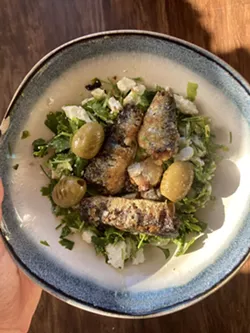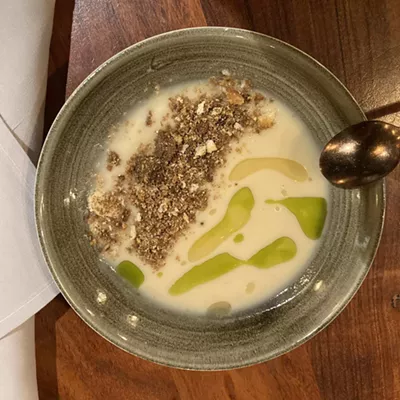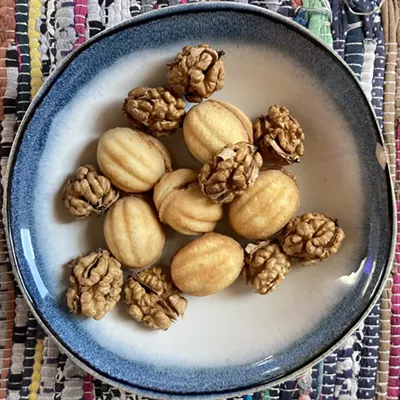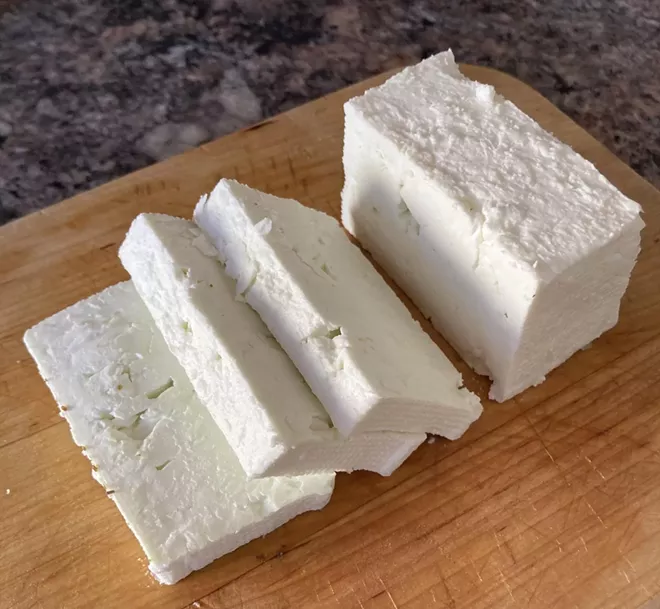
This is an installment of the Inlander's yearlong project "Around the World in 80 Plates," a quest to find 80 foods and drinks in the Spokane area representing 80 different places. Read the introduction to the project here.
Count of dishes/places: 49
Some cuisines get all the attention — in movies, restaurants, enclaves in big cities. Greek, Italian, Mexican, Chinese, these are international flavors so popular that we barely think of them as imports anymore. Tortillas, alfredo sauce, feta cubes and soy sauce are all familiar faces in a standard grocery aisle.
But some cuisines, either because of fewer immigrants or a less successful PR team, haven't become so mainstream. When shoppers discover a new-to-them foreign product, they tend to compare it to something they already know.
It's helpful to a degree, but the comparison often entrenches one cuisine as the norm and the other as an outsider.
Case in point: Bulgarian "feta."
Bulgaria borders Greece and is home to the Balkan Mountains, the mountain range that gives the entire peninsula off the southeast corner of Europe its name. The core Balkan nations in addition to Bulgaria are Albania, Bosnia and Herzegovina, Croatia, Kosovo, Montenegro, North Macedonia, Romania, Serbia and Slovenia, with parts of Greece and Turkey sometimes included, too.
Granted, similar climate and geography often produce similar foods throughout the region. But somehow, Greek feta has become the norm in the U.S., while other white brined cheeses like Bulgarian sirene, Romanian telemea, or Lebanese jibin remain largely unrecognized.
In fact, most Balkan and Middle Eastern countries have their own version of a white brined cheese from some combination of sheep, goat and cow milk. But if they're sold in American grocery stores, they're almost always considered an off-brand feta.
It's like if every wheat tortilla you saw in the store was advertised as "Mexican naan."
So this installment of Around the World in 80 Plates is dedicated to white brined cheese and yogurt from Bulgaria. These two cultured dairy products are common across the Balkan peninsula and beyond, even though Greece has nearly monopolized them in the minds of American shoppers. But I'll try my darnedest to let these Bulgarian products shine on their own.
SIRENE FROM THRACE
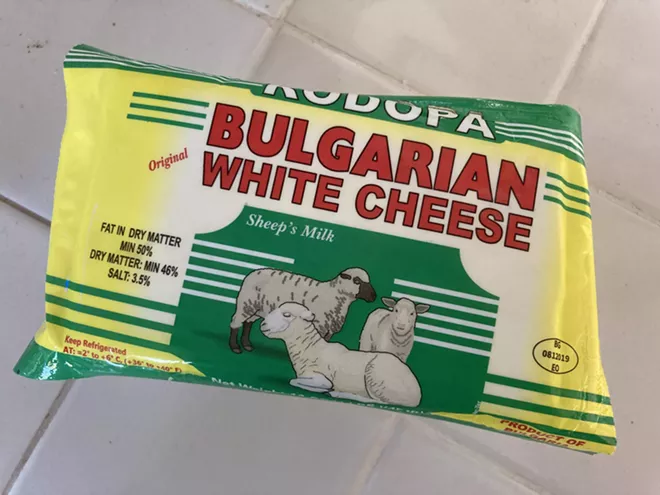
Saying "sirene cheese" is as redundant as saying "naan bread" or "chai tea." Sirene is the Bulgarian word for cheese, and though there are other kinds of cheese in the country, their white brined cheese is so ubiquitous that it's the default.
Scholastic articles repeat that the Balkan peninsula was making cheese by 5000 BCE, if not before. Though fermented dairy products were probably discovered by accident — raw milk stored in clay pots or animal skins and left a little too long in the sun — some historians believe that an ancient Thracian tribe were among the first people to prepare yogurt and cheese on purpose. (Thrace is an ancient name for the Balkan region.)
The mountains and rocks that make up the peninsula aren't very hospitable to lots of cattle, but they do support smaller herd animals like sheep and goats just fine.
Most cheeses from the region feature different combinations of sheep and goat milk, plus a little from cows if it happens to be available. Before refrigeration, cheese was stored in brine so the salt would help preserve it longer.
The whole region shares this basic process, which produces cheeses that are similar but endlessly different. Flavor depends not only on the mixture of sheep, goat and cow milk, but also the local flora that the herds are grazing on. Just like honey from different places tastes different based on the diet of the hive, local cheese can reflect local plants and seasons.
This celebration of diversity is a different philosophy than the approach to feta, which is now defined and protected by the European Union. According to the EU, feta is only made in Greece from the milk of specific sheep and goat species that have grazed on native Greek flora. Of the 6,000 different plant species in Greece, 15% are unique to its borders.
The EU definition guarantees a consistent product that tastes a certain way (in Europe at least, not in the U.S. — feta in American grocery stores doesn't even have to be made in Greece). But it creates an exclusionary culture that doesn't celebrate the endless variation that the region has to offer.
Sirene, for example, is less salty and more creamy than its Greek counterpart. It's texture could even be considered a bit waxy. Traditional uses would be in a tomato and cucumber salad called shopska, or a filled phyllo dough pastry called banista.
The sirene I bought at Damas Middle Eastern Grocery on Thierman Road in East Spokane had more lemon notes to it than I expected. In my mind, that made it perfect for fish, herbs, or summer vegetables. I found that the new-to-me cheese inspired me to think about other ingredients in my kitchen in new ways.
I used sirene in salads with fresh cucumbers, torn sourdough and grilled olives to add a salty, citrus kick. I also mixed it with a ton of herbs for a tangy "undersalad" for grilled sardines.
Neither of these plates are at all Bulgarian. But maybe the philosophy of using what you have, leaning into nuances of flavor, and being inclusive instead of exclusive is.
YOGURT FROM STUDEN IZVOR
Yogurt wasn't actually invented in Studen Izvor, but the small Bulgarian town is central to what's probably the biggest yogurt discovery of the 20th century.
Bulgaria claims to be the origin country of yogurt. It's certainly debatable. But it's undeniable that Bulgaria has its own strain of bacteria that makes its yogurt specific, unique, and very healthy. It's called bacillus bulgaricus, and it was discovered by Bulgarian scientist Stamen Grigorov.
Grigorov was born in Studen Izvor in 1878. At the turn of the century, Grigorov was a young research assistant working at the Medical University of Geneva, Switzerland. His wife sent him Bulgarian yogurt from home, and Grigorov got interested in the unique health benefits of a food every Bulgarian grew up with.
In 1905, Grigorov discovered a certain bacillus unique to Bulgarian yogurt and named it after his home country. He found that the bacteria isn't native to the human gut microbiome, but can be very beneficial to it. Grigorov may just be the godfather of our modern gut health craze.
Building off Grigorov's work, Russian scientist and Nobel Prize laureate Ilya Mechnikov eventually credited Bulgarian yogurt for keeping its eaters so healthy. In his study of 36 countries, more people lived to 100 years old in Bulgaria than anywhere else. Take that, Ikaria, Greece (of Blue Zone fame).
The health benefits of Bulgaria's favorite dairy product, discovered relatively recently compared to how long Bulgarians have been eating yogurt, have only increased national pride. Studen Izvor is now home to the world's premier yogurt museum in Grigorov's honor.
Despite the pots upon pots of Greek yogurt in the refrigerated section, I spied two kinds of Bulgarian yogurt in the cold case at My Fresh Basket in Kendall Yards. One from White Mountain, and one from Trimona.
After some serious "eeny, meeny, miny, moe," I grabbed Trimona. It was a little tangier and thinner than Greek yogurt, but still felt way healthier than your typical Yoplait.
Trimona's website says Bulgarian yogurt isn't strained, which keeps the highest quality protein and the most minerals in the final product. I don't think all Bulgarian yogurt is made from A2A2 milk, which is supposedly easier to digest, but it's a major part of Trimona's identity. The brand was created by Atanas Valev, a Bulgarian in the U.S. who made his own yogurt with mother cultures from his home country.
As consumer concern with gut health increases, watch to see if Bulgarian yogurt pops up in more and more health stores and grocery shops near you. It might just give Greek yogurt and its PR team a run for its money. ♦
Have an idea for what I should eat next? Wanna make me a traditional dish from your hometown? Send 80 Plates tips and ideas to elizab@inlander.com.

